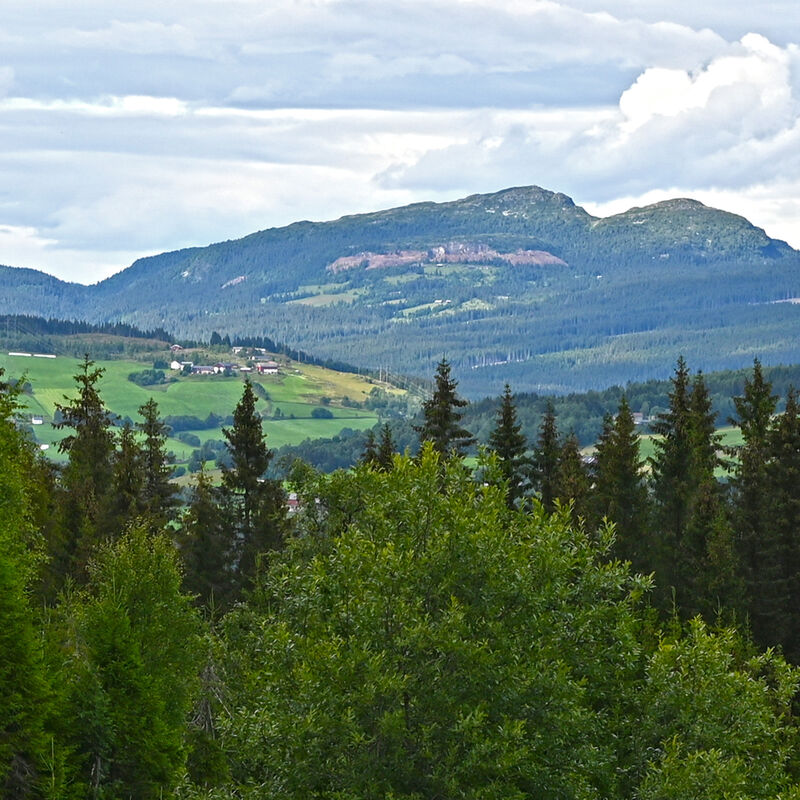Gausdal is a rural municipality in the county of Innlandet. Gausdal was previously in Oppland county, but in January 2020 the two counties of Oppland and Hedmark were combined and are now known as Innlandet - an inland county with no coastline. In 1962 the administrative areas of Østre and Vestre Gausdal - the two main valley areas, east and west - were merged and Gausdal municipality was established. Gausdal borders Øyer in Gudbrandsdalen to the east, Lillehammer and Nordre Land to the south, Nord-Aurdal and Østre Slidre to the west and Sør-Fron and Ringebu to the north.
Landscape and geology
In the valleys and part of Gausdal Vestfjell the underlying rock is slate, otherwise it is predominantly sparagmite. There have been many finds of ore and there were a number of nickel mines in Espedalen in the nineteenth century. The lower slopes are forested, and there are many mountains above the treeline in the higher areas to the north, eg. Skeikampen (1124 m) and Prestkampen (1244 m) lie to the north on the border with Ringebu. Many splendid mountain peaks lie beyond the summer farms and marshy areas to the west, and in the northwest lies Gausdal’s highest peak Langsua (1554 m) on the border with Sør-Fron. The whole of Gausdal Vestfjell is state-owned common land, and in 2011 a large area became part of Langsua National Park, with adjoining protected landscapes and nature reserves. There are many lakes and rivers for fishing and there are endless possiblities for trips in the forests and mountains.
Settlement and population
Gausdal municipality has 6 104 inhabitants (2022 SSB). Many live within a 10 km radius of the administrative centre Segalstad Bru (population 996 in 2017) including the villages of Follebu (pop. 1156) and Forset (pop. 583). Gausdal has had a population of between 5000 and 7000 since the 1830’s, with peaks in the years around 1860 and 1950. During the last ten to fifteen years the population figures have remained stable.
Commerce and industry
Gausdal has a robust and active agriculture industry, primarily within dairy farming and meat production, as well as a significant amount of forestry. Agriculture provides a good foundation for various production industries. Gausdal has a number of larger businesses within the timber industry - a sawmill and factories making roof trusses and prefabricated elements for house-building. The privately owned dairy Q-Meieriet also has a large production unit in Gausdal.
Tourism
Travel and tourism is a growth area. Skeikampen is a mountain hotel resort, with many lodges, apartments and private cabins and there is extensive development. There are excellent downhill and cross-country skiing facilities, an 18-hole golf course and many paths and tracks for hiking, cycling and cross-country skiing, see Skeikampen.no for more information. Lillehammer is a tourist hub for the region - see Visit Lillehammer for tourist information in English, German and Norwegian.
The FV255 Fåberg-Vinstra road goes through Gausdal. It is a scenic route known as Bjørnsonvegen, the Bjørnson road, with many places of interest to visitors. The FV254 goes through Østre Gausdal to Tretten, branching off to Skeikampen. There is road from Skeikampen over the mountains to Vinstra, only open in the summer months - Peer Gynt Vegen. There is also a mountain road open from Vestre Gausdal going west to Etnedal and Fagernes during the summer months. This road network is important for tourist traffic.
History and culture
The most well known tourist attraction in Gausdal is the Nobel prize-winner Bjørnstjerne Bjørnson’s home, Aulestad, in Follebu. The house has been carefully renovated and kept just as it was when Bjørnson and his wife Karoline lived there together until the early part of the 20th century. The house and museum is only open during the summer months, the garden and grounds are open all year round.
There are two fine examples of stone churches dating from the Middle Ages in Gausdal – Follebu and Østre Gausdal, both of which are protected buildings. In the Vestfjellet mountain area there is an open-air museum, Kittilbu Utmarksmuseum, and Langsua National Park. Other significant buildings in Gausdal include: Vonheim, in Follebu, previously a folk high school; the captain’s farm at Bauker; Østre Gausdal vicarage and the old coaching station at Veisten, in Forset.
The municipality’s coat of arms (from 1986) is divided into blue and silver by an inclined step profile, illustrating the typical mountain formation seen in Gausdal. The name of the municipality comes from the norse ’Gausdalr’, from the river Gausa, ’stri strøm, foss’ meaning ’strong current, waterfall’.

